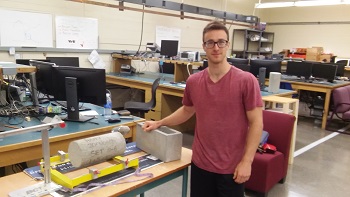Blog post by student researcher:
Miles Adamson, School of Computing and Academic Studies
 The non-destructive acoustic resonance testing project – NDART for short — that I am working on aims to create a smartphone app which can measure the strength of concrete blocks from the sound they make. The standard method of insuring the quality of blocks is to select random samples from the batches produced by a manufacturer and crush them to estimate the strength of the remaining blocks. While this technique is very effective, the strength testing apparatus is too expensive for most developing economies to adopt. The absence of a low-cost, reliable alternative method for estimating the strength of masonry units leads to preventable deaths when structures collapse during an earthquake.
The non-destructive acoustic resonance testing project – NDART for short — that I am working on aims to create a smartphone app which can measure the strength of concrete blocks from the sound they make. The standard method of insuring the quality of blocks is to select random samples from the batches produced by a manufacturer and crush them to estimate the strength of the remaining blocks. While this technique is very effective, the strength testing apparatus is too expensive for most developing economies to adopt. The absence of a low-cost, reliable alternative method for estimating the strength of masonry units leads to preventable deaths when structures collapse during an earthquake.
The NDART project relies on tying the physical properties of concrete blocks to the sound it makes when it vibrates in response to being struck. The NDART group has shown that the frequency content of the sound is strongly correlated to the strength of the block. Since the sound generated is carried through the air, a cell phone can capture it with its microphone and then analyze it. Even in third world locations, cell phones are very common and accessible.
My role was to refine the cell phone App on an Android phone, to identify how concrete blocks vibrate when struck at different locations, to discriminate between sounds produced by the concrete and background noise, and to create a cloud-based database to hold the results of analyzed recordings produced by the cell phone. To do this, I installed a server on a computer at BCIT which had a relational database. I added to the app so that it could communicate with this server through HTTP. The server then ran PHP scripts I wrote to manage the database. The result of my work is a system where a user can log in to the system, then save, view or delete results from a logbook table. In short, this innovation will help to give NDART global reach.
During my work term, I really enjoyed putting the skills I learned at BCIT into practice. The work reminded me of my capstone project, because while the project has a clear end goal, figuring out the path to it is the exciting part. Overall I used a huge amount of the skills I learned during my degree, like signal processing, programming and software design. Some lab activities at BCIT were incredibly similar to the work I was doing. This made me feel prepared for the job, but there was continuously so much to learn, which is really what made the experience so rewarding.